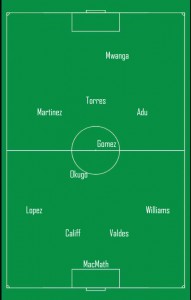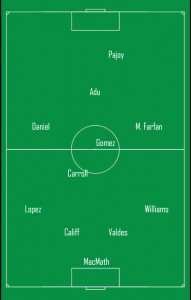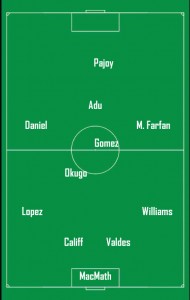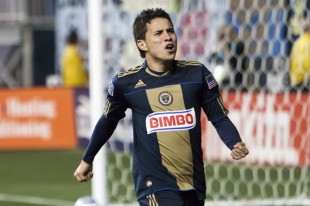Photo: Daniel Gajdamowicz
Following the analysis of both the 4-3-3 and 4-4-2 formations, PSP’s Eli Pearlman-Storch takes a look at the 4-2-3-1 in the final installment of a three-part series about potential Union formations in 2012.
While a 4-2-3-1 may not seem the most likely setup for the Union to employ in 2012 given their stable of young strikers, it provides an opportunity to dominate the center of the pitch, an area where they struggled in 2011. It is hard to imagine that a team who plays as narrow as the Union would struggle in the heart of the park, yet with so many roaming attackers—making dangerous runs but not always covering back to fulfill their defensive responsibilities—the holding players in the Union midfield were stretched too far and too frequently and thus dropped deep, just in front of the back four. The result was that they conceded territory to opposing playmakers, allowing for the creation of dangerous goal-scoring opportunities in the process.
With two holding players protecting three attackers, all in the midfield, the Union would begin each match with a numeric advantage they lack in a 4-4-2 and, given the Union’s lack of true wide players on the roster, the 4-2-3-1 provides more players the chance to move through center of the pitch without unbalancing the formation.
Still, with only two players who can really fill the role of target forward—Danny Mwanga and Lionard Pajoy, and Mwanga still has some proving to do—the Union will have to bank on both players having career years and remaining injury-free throughout 2012. Injuries aside, more minutes and responsibility for the maturing Mwanga can’t be anything but positive for the Union No. 10, who is looking to have a breakout season, while Pajoy joins the Union at a time when he has played the best soccer of his career over the past year.
Mwagic Show
While there will be no dearth of players ready to get forward in attack, the task of occupying both central defenders, winning balls in the final third, and creating space in the attacking third falls to Mwanga. Or Pajoy, when he enters the game. For Mwanga to be successful in this capacity, he must continue his maturation process and show that 2012 is the year in which he continues improves on his hold up play while also becoming the aerial force that the Union require. As the lone striker in a 4-2-3-1, Mwanga must make the leap from a slowly developing phenom into a wiser, veteran presence, prepared to show patience with his back to goal, challenging defenders both with the ball at his feet and without, all while keeping his head up to set the table for his teammates. It is a lot to ask of the still 20 year-old Mwanga, especially considering the physical abuse a lone striker inevitably endures, but if the coaching staff maintains a consistent rotation between Mwanga and the more seasoned Pajoy, they could manage to get the most out of both players.
Three-headed midfield monster
Both in 2010 and 2011, Peter Nowak’s predilection for rotating his squad while they’re on the pitch often rendered the discussion of formation useless once a match kicked off. In this instance, it would likely be no different, since while Roger Torres might start centrally between Freddy Adu and Josue Martinez at the opening whistle, both wide players will inevitably take turns up top running off Mwanga, switching their wing to find new angles of attack, and rotating through the middle of the park. Martinez, like Jack McInerney and Chandler Hoffman, wants to be as high as possible to terrify defenses with the angle and pace of his runs. This might even result in 4-2-2-2 at times as Adu tucks in alongside Torres with Martinez working on a higher line with Mwanga.
Regardless, these three players—along with Michael Farfan, McInerney, Hoffman and others off the bench—have pace, guile and aggression in spades. With all three setting up camp in front of the opposition’s back four, they create enormous match-up headaches for any coach they face. With Mwanga or Pajoy occupying the centerbacks, the fullbacks must worry about stepping too high to engage for fear of allowing any one of the triumvirate to burst through into space behind them. Also, any defender would be remiss to overlook the ever looming threat of the Union’s high-flying fullbacks.
One holding midfielder can mark one player, but with two other advanced attackers joining the party the Union will either find pockets of space behind the midfield or their opponent will be forced to abandon their own game plan and drop extra numbers into defense. Either scenario suits the men in navy and gold as there is too much quality up and down this roster not to generate sufficient chances in 2012.
Jet-pack fullback
Whether or not the rotation in the attacking midfield line creates the desired confusion among the opposition’s defense, one thing is certain: It will make the Union very narrow in attack. Josue Martinez relies on his striker’s tendencies and will be best suited to run off of Mwanga’s shoulder on the left, while Freddy Adu’s playmaking ability comes from cutting in off the right wing, onto his favored left foot. With the six midfielders and forward operating out of roughly the central third of the pitch, Sheanon Williams’ and newcomer Porfirio Lopez’s surging runs forward will become more important than ever.
In 2012, the Union are still unlikely to power home a large number of headed goals, but with the both fullbacks bombing forward to aid in possession, spread the field, and add bodies that must be marked, no opposing side will be able to match the Union in the center of pitch. To that end, Williams and Lopez must make the opposition fullbacks and outside midfielders respect the threat they pose, broadening the field and giving the Union a numerical and strategic advantage through the heart of the park.
Build Together
With Williams and Lopez required in attack, Amobi Okugo’s skill set makes him a better central midfield partner for Gabriel Gomez than the incumbent, Brian Carroll. In Orlando, the Union experimented with dropping a central midfielder into a makeshift three-man backline when the fullbacks attacked. First Gomez filled this role in the opening half, then Okugo in the second. With Gomez needed higher up the pitch in attack it was surprising that Carroll never took up this role. Okugo’s defensive instincts, range, and skills on the ball make him better suited to occupy the role of the second, more defensive minded, holding player.
Between Torres, Gomez and Okugo, the Union have three central midfielders who are willing and capable of dropping deep to receive the ball and start a patient, well-built attack. Too often, Carroll’s lack of comfort in the possession game resulted in Carlos Valdes and Danny Califf wandering forward looking for a passing option. These meandering runs from the team’s centerbacks, while suitably dangerous in 2011, could spell trouble for the Union this year, given that they will likely release their fullbacks at every opportunity.
Inverting the triangle
As the match wears into the second half, the 4-2-3-1 provides the Union with the option to invert the triangle, pushing both wide players high up the pitch to more closely resemble a 4-3-3 as they seek out an equalizing or match-winning goal. If necessary. they can increase their defense fortitude and fall into a 4-5-1 to protect a lead.
With Jack McInerney entering a match, the Union would have three true strikers on the pitch. Martinez could roam higher and continue to be aggressive on the left while McInerney would bring the danger on the opposite side. Whether it is Adu or Torres who remains to run the midfield alongside an ever advancing Gabriel Gomez, the Union will have retained enough creative playmaking talent to set the table for all three strikers. Bringing on Pajoy for an inevitably tiring Mwanga, and Michael Farfan to add energy in the attack, the Union can refresh their lineup, and become more aggressive without sacrificing their shape.
To hold and maintain a lead, the incorporation of strong, savvy players like Keon Daniel, Pajoy and Marfan gives the Union the kind of tough, more defense/possession lineup required to grind out results. In doing so, the Union needn’t bring on any defensive-specialists and thus can maintain a strong line in midfield, pressuring the ball well before it crosses the midfield stripe. By not ceding territory, and maintaining consistency in possession, the Union need not fall into a shell and so can keep the fight as far from Zac MacMath as possible.
Have questions that you’d like the PSP’s Eli Pearlman-Storch to answer in a post? Send them to epstorch@phillysoccerpage.com along with your full name and where you live, both in PPL Park and in the world, and he will get to them in an upcoming post on the Philly Soccer Page.






Your first lineup picture is fantastic and I would roll it out on the field every game I could. But the chances we see it? Very low.
Sounds nice. However, it is my belief that the coach should constantly intervene, in formations and line ups- in order to foster competition, while preventing both comfort (and the discovery of form that goes with it), and an understanding of the player’s responsibility. This is a truly genius way to run a soccer team, though I don’t expect you to understand this. In fact, I’m angered that you are making me take time out of plotting my ingenious changes to explain why I do it.
Has there been a write up on the 4-3-2-1 (or -1-2)?
When did Okugo jump ahead of Carroll in the barking order? Not complaining but every other formation has Carroll as the first pick DM.
Anyways. Torres and Adu shouldn’t touch the field together in my opinion. Especially closely to each other. If we’re looking to draw freekicks, sure. ButTorres has 0 stamina. After half time when he started, he becomes less aware of the game and draws an early sub. Anyways, Marfan/Torres any day of the week. He has great vision, he’s physical, and I think he does wonders with the ball in one-on-one situations. In a CAM he’s everything we need.
Love it for the most part! Would rather she Carrol than Amobi because Amobi’s likely going to be gone for the Olympics anyways. And we need to find some way to get Michael Farfan on the pitch as much as possible IMO
Marfan should be in every starting 11.